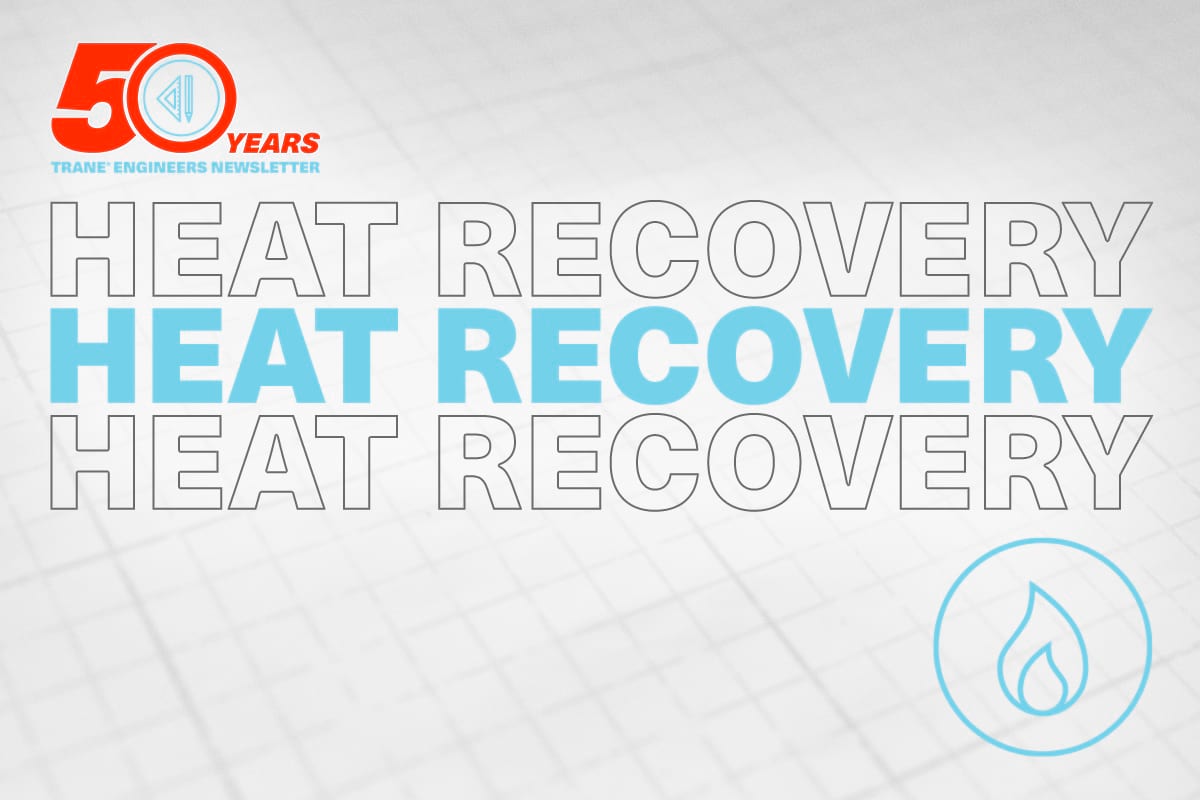
The warmth of the summer sun feels terrific after a lengthy, frigid winter but when it gets to be too much an escape to the cool, refreshing indoor air conditioning is a welcomed break. And living in western Wisconsin I can surely claim I enjoy both -- nothing feels more rejuvenating than an air-conditioned space after a hot, sunny day on the Mississippi River! My name is Dan Gentry, and I recently celebrated my five-year anniversary with Trane; I started my career with the company in the Centrifugal Product Support group. Previously, I worked in sales support at another chiller manufacturer where I primarily focused on heat recovery and heat pump type systems. About a year ago in the spirit of leveraging and strengthening my work experience, I transitioned to the role of Applications Engineer and now work with the field to help design energy-efficient systems, many of which utilize some form of heat recovery, often with heat recovery chillers.
In this month’s 50-year Engineers Newsletter anniversary blog we will review water-side heat recovery. “Everything old is new again!” was the title of the 2007 EN on the topic of water-side heat recovery. Funny how that phrase was as accurate then as it is today. One section of this EN describes how heat recovery was all the craze in the 1970s due to the oil embargo. Fast forward to present day and energy efficiency and heat recovery have become a staple of most projects. Not only do customers want comfortable and efficient buildings to operate, but most now want to incorporate sustainability into their buildings so they have minimal environmental impact today and into the future. Heat recovery systems can help play an instrumental role in achieving these goals. This goes back to one of the first things I learned when diving into the world of heat recovery:
Why remove heat and add heat to a building at the same time? Wouldn’t it make more sense to simply move the heat from where it is not needed and place it in the space where it is needed?
That seemed simple and reasonable to me many years ago and still does today.
If you haven’t heard of decarbonization and electrification yet you may be living under a rock. I believe these buzzwords are also the biggest trend many of us in the HVAC industry have seen during our careers so far or will continue to in the future. This is an exciting time for designers too as new opportunities to develop products, systems and solutions will arise as we electrify and decarbonize our buildings and grids. Heat recovery is one of those levers we will be utilizing to help our customers achieve their goals.
As stated earlier, everything old is new again, and that is still true today. Trane has been producing products, systems and documentation related to heat recovery for over 50 years! Below is just a sampling of the previous ENs Trane has produced over the decades. The library of resources related to heat recovery in HVAC is no less than impressive. If you’re interested in these or other resources, contact your local Account Manager to learn more. I hope everyone has a wonderful summer filled with simultaneous heating and cooling!
- 1974 Heat Recovery Systems-Part 1 and Part 2 (ENEWS Volume 3, Numbers 6 and 7)
- 1974 The Coil Run-Around Cycle-Part 1 and Part 2 (ENEWS Volume 3, Numbers 3 and 5)
- 1975 Heat Pump Application (ENEWS 4_3)
- 1977 Heat Recovery: Trends in A/C Systems (Air & Water) (ENEWS-6_4)
- 1978 The Load-Shedding Economizer: Heat Recovery (ENEWS-7_4)
- 1978 Centrifugal Chillers with Domestic Water Preheat Waterside (ENEWS-7_2)
- 1978 Heat-Recovery Reciprocating/Centrifugal Chiller Combination: A TRACE Analysis (ENEWS-7_1)
- 1986 Heat Recovery, Air Conditioning & Today’s Technology (ENEWS-15_1)
- 1989 How Two Losers Combine to Form One Winner (ENEWS-18_3)
- 2007 Waterside Heat Recovery: Everything Old Is New Again Schwedler, M. Waterside ADM-AP
Engineers Newsletter

About the author
Dan Gentry, Applications Engineer
Dan Gentry is an Applications Engineer based in La Crosse, Wisconsin. He joined Trane in 2018 after eight years at another local Wisconsin-based chiller manufacturer. Dan first interned at Trane in the Technology Lab while attending school through 2008. His areas of expertise revolve around chiller plants, heat recovery and heat pump systems and their reliable and efficient design and operation.
Dan graduated from Ferris State University in 2011 with a Bachelor’s Degree in HVAC Engineering Technology and is an active member of ASHRAE. Dan enjoys spending time with his family on the river and relaxing at the family cabin up north.
































































































